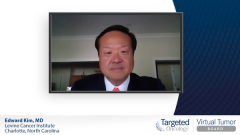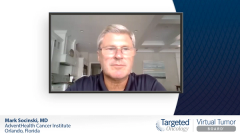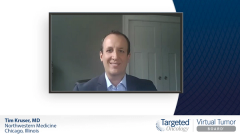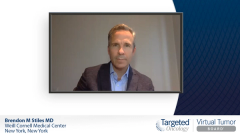
Case 2: Biomarker Testing for Non–Small Cell Lung Cancer
Episodes in this series

Mark Socinski, MD: There's obviously a growing list of actionable biomarkers with FDA-approved therapies. I’ve been saying for quite some time now that I think one of the greatest things we do as medical oncologists is diagnosing an oncogenic driver where we have an FDA-approved agent. These agents work so much better than chemotherapy. We know that from the EGFR and ALK space, and this is not a group that historically we think gets a great benefit from immunotherapy. Most of the oncogenic drivers were essentially excluded from the vast majority of trials of chemoimmunotherapy, except for a few like IMpower150. I actually am pretty aggressive about testing. I don’t know what Ed does, but in my practice, I do both tissue and plasma at the time of diagnosis. We had the NILE trial, which suggested that you can find things in plasma you don’t find in tissue. If you live by the credo of never miss an oncogenic driver, I think plasma plays an important part of your initial comprehensive molecular evaluation.
Edward Kim, MD: I will say, Mark, that is progressive and I agree with you. I think that’s the general direction it’s going for sure. We collect both, we don’t run them simultaneously. With the Tempus testing platform you collect both, and then we run the reflex if the tissue doesn’t come back. I agree, I think doing both of them is definitely progressive and helpful.
Mark Socinski, MD: Yes, and many years ago, addressing the second issue here about the smoking history, I think Vince Miller, when he was still at Memorial Sloan-Kettering Cancer Center actually presented some data at ASCO. He said that if you restricted your EGFR mutation testing to never-smokers, you would miss 60% of the EGFR mutations. So there really are no clinical features, it should be the histologic diagnosis that should force you to do the comprehensive testing. You can’t say in an adenocarcinoma, this case here, this woman has a 55-pack-year history of smoking. You’re still going to test her, right?
Edward Kim, MD: Yes. We do the same, we base it more on the histology. You can understand the way old school sort of held on because the way we even got to these biomarkers was because of clinical history, the Asian, never-smokers with adenocarcinoma, and that was always the last part. So I get it, people like to hold on to the oldies but goodies, but no, you need to just test.
Mark Socinski, MD: What’s the specific message you would give to the audience now, knowing that she’s strongly PD-L1–positive, but we don’t know any of her molecular genomics yet? What would your message be?
Edward Kim, MD: I’m happy we got something positive. Let’s hope we get something else off the other panel because that will make me even happier. We always go with a driver mutation, and we have to be cautious when we have EGFR mutations present, for instance, giving immunotherapy because some of the data have not been favorable and in fact been harmful.
Mark Socinski, MD: Yes, and this summarizes the data here. Again, to Ed’s point, Eddie Garon really led the charge in the initial observation of taking patients who were EGFR mutation-positive and had high PD-L1 expression, giving them pembrolizumab in the first-line setting, kind of went 0 for 10. There was 1 patient who had a response, but that patient was later found to be EGFR mutation negative. When they all progressed, they rolled over to osimertinib, and there were 2 deaths within 6 months of enrollment, including 1 attributed to pneumonitis. So the take-home message is you should have concern. There have also been some data in the ALK space with the same concerns; in that case, a couple of issues with hepatitis.
Really, the take-home message is make sure you have all the information you need to make the decision. Obviously, molecular testing may take a little bit longer, but it’s important to wait for those results. This slide again brings home the point that I just made. Particularly with osimertinib, you can see that that sequence of PD-1, PD-L1 blockade followed by osimertinib does carry with it the risk of severe immune-related adverse events. You don’t want to put your patient in that position by pulling the trigger on immunotherapy too quickly before you know the results of the genomics in this testing. It’s been incorporated into the NCCN recommendations, as well as the SITC recommendations shown here. So it’s an important point to make with regard to managing this population.
Transcript edited for clarity.










































